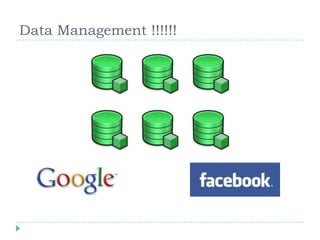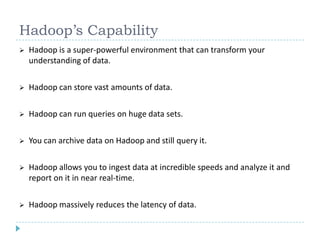Hadoop
- 4. Big Data-What does it mean? Velocity: Often time sensitive , big data must be used as it is streaming in to the enterprise it order to maximize its value to the business. Batch ,Near time , Real-time ,streams Volume: Big data comes in one size : large . Enterprises are awash with data ,easy amassing terabytes and even petabytes of information. TB , Records , Transactions ,Tables , Files. Variety: Big data extends beyond structured data , including semi-structured and unstructured data to all varieties :text , audio , video ,click streams ,log files and more Structured , Unstructured , Semi-structured Veracity: Quality and provenance of received data. Good , Undefined , bad , Inconsistency , Incompleteness , Ambiguity Value
- 5. Big Data 90% 10% Worldwide Data Last 2 years Since the Beginnning of the Time
- 6. What is Hadoop? Software project that enables the distributed processing of large data sets across clusters of commodity servers Works with structured and unstructured data Open source software + Hardware commodity = IT cost Reduction It is designed to scale up from a single server to thousands of machines Very high degree of fault tolerance softwareâs ability to detect and handle failures at the application layer
- 7. The origin of the name HadoopâĶ. The name Hadoop is not an acronym; itâs a made-up name. The projectâs creator, Doug Cutting, explains how the name came about: The name my kid gave a stuffed yellow elephant. Short, relatively easy to spell and pronounce, meaningless, and not used elsewhere: those are my naming criteria. Kids are good at generating such. Googol is a kidâs term.
- 8. Hadoop Sub-projects ï― HDFS ï― Map-Reduce
- 9. HDFS-Hadoop Distributed File System ï Distributed, scalable, and portable file system ïEach node in a Hadoop instance typically has a single Namenode : a cluster of Datanodes form the HDFS cluster ïAsynchronous replication. ïData divided into 64mb (default) or 128mb blocks , each block replicated 3 times (default) ïNamenode holds file system metadata. ïFiles are broken up and spread over Datanode .
- 10. HDFS- Read & Write
- 11. MapReduce ïSoftware framework for distributed computation ïInput | Map() | Copy/Sort | Reduce () | Output ïJobTracker schedules and manages jobs. ïTask tracker executes individual map() and reduce task on each cluster node.
- 13. Master â Slave Model
- 14. Hadoop Ecosystem
- 15. HBase ï HBase is an open source , non-relational, distributed database ï A Key-value store ï― A value is identified by the key ï― Both key and value are a byte array ï The values are stored in key-order ï― Thus access data by key is very fast ï Users create table in HBase ï There is no schema of HBase table ï Very good for sparse data ï Takes lots of disk space
- 16. HBase Architecture ï Master: Responsible for coordinating with region server. ï Region server: Serves data for read and write ï Zookeeper: Manages the HBase cluster ï Low latency and random access to data
- 17. Hive ï A system for managing and querying structured data built on Hadoop ï SQL-Like query language called HQL ï Main purpose is analysis and ad hoc querying ï Database/table/partition âDDL operation ï Not for :small data sets ,Low latency queries ,OLTP
- 19. HBase-Hive configuration HBase as ETL data sink HBase as Data Source Low Latency warehouse
- 20. Hive and MySQL Database Structure
- 21. Hadoop Limitations ï Not a high-speed SQL database. ï Is not a particularly simple technology. ï Hadoop is not easy to connect to legacy systems. ï Hadoop is not a replacement for traditional data warehouses. It is an adjunctive product to data warehouses. ï Normal DBAs will need to learn new skills before they can adopt Hadoop tools. ï The architecture around the data - the way you store data, the way you de-normalize data, the way you ingest data, the way you extract data - is different in Hadoop. ï Linux and Java skills are critical for making a Hadoop environment a reality.
- 22. Hadoopâs Capability ï Hadoop is a super-powerful environment that can transform your understanding of data. ï Hadoop can store vast amounts of data. ï Hadoop can run queries on huge data sets. ï You can archive data on Hadoop and still query it. ï Hadoop allows you to ingest data at incredible speeds and analyze it and report on it in near real-time. ï Hadoop massively reduces the latency of data.
- 23. Hadoop: Hot skill to acquire on IT job circuit ï The market for data technologies, such as databases, is a multi-billion dollar industry. ï Many start-ups are working on technology extensions to Hadoop to make it both analytical and transactional. That would be big. ï Major companies have a big data strategy and want to build their businesses on top of this ï Google, the originator of Hadoop, has already moved on â suggesting that within a decade either the Hadoop framework will have to be developed beyond all recognition or that something newer could be on the way to supplant it. ï Every major internet company - be it Google, Twitter, Linkedin or Facebook - uses some form of Hadoop .

























